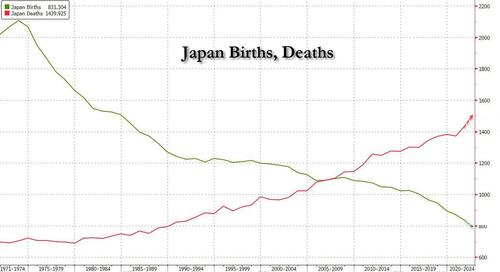Japan’s Population In Freefall As Twice As Many People Die As Are Born
Japan’s population is in freefall.
In 2022, the number of births registered in Japan plummeted to another record low last year according to statistics released by the Ministry of Health – the latest worrying statistic in a decades-long decline that the country’s authorities have failed to reverse despite their extensive efforts.
The country saw just 799,728 births in 2022 – the lowest number on record and the first ever dip below 800,000 – and about half of the number of deaths, which at more than 1.58 million, was a record high. The number of births in Japan has nearly halved in the past 40 years: in 1982, Japan recorded more than 1.5 million births, a number which was then more than double the number of deaths. This ratio has since reversed.
As shown in the chart above, deaths have outpaced births in Japan for the past 15 years – a trend which is unlikely to reverse ever again – posing an existential problem for the (aged) leaders of the world’s third-largest economy. They now face a ballooning elderly population, along with a shrinking workforce to fund pensions and health care as demand from the aging population surges.
Japan’s population has been in steady decline since its economic boom of the 1980s and stood at 125.5 million in 2021, according to the most recent government figures.
According to CNN, Japan’s fertility rate of 1.3 is far below the rate of 2.1 required to maintain a stable population, in the absence of immigration.
The country also has one of the highest life expectancies in the world; in 2020, nearly one in 1,500 people in Japan were age 100 or older, according to government data.
These concerning trends prompted a warning in January from Prime Minister Fumio Kishida that Japan is “on the brink of not being able to maintain social functions.”
“In thinking of the sustainability and inclusiveness of our nation’s economy and society, we place child-rearing support as our most important policy,” he said, adding that Japan “simply cannot wait any longer” in solving the problem of its low birth rate.
A new government agency will be set up in April to focus on the issue, with PM Kishida saying in January that he wants the government to double its spending on child-related programs. But money alone might not be able to solve the multi-pronged problem, with various social factors contributing to the low birth rate.
Japan’s high cost of living, limited space and lack of child care support in cities make it difficult to raise children, meaning fewer couples are having kids. Urban couples are also often far from extended family in other regions, who could help provide support.
In 2022, Japan was ranked one of the world’s most expensive places to raise a child, according to research from financial institution Jefferies. And yet, the country’s economy has stalled since the early 1990s, meaning frustratingly low wages and little upward mobility: the average real annual household income declined from 6.59 million yen ($50,600) in 1995 to 5.64 million yen ($43,300) in 2020, according to 2021 data from the Ministry of Health, Labor and Welfare.
Attitudes toward marriage and starting families have also shifted in recent years, with more couples putting off both during the pandemic — and young people feeling increasingly pessimistic about the future.
In 2022, Japan was ranked one of the world’s most expensive places to raise a child, according to research from financial institution Jefferies. And yet, the country’s economy has stalled since the early 1990s, meaning frustratingly low wages and little upward mobility.
The average real annual household income declined from 6.59 million yen ($50,600) in 1995 to 5.64 million yen ($43,300) in 2020, according to 2021 data from the Ministry of Health, Labor and Welfare.
Attitudes toward marriage and starting families have also shifted in recent years, with more couples putting off both during the pandemic — and young people feeling increasingly pessimistic about the future. Who can blame them for not feeling frisky.
It’s a familiar story throughout East Asia, where South Korea’s fertility rate — already the world’s lowest — dropped yet again last year in the latest setback to the country’s efforts to boost its declining population.
Meanwhile, in January China just lost its title as the world’s most populous country to India after its population shrank in 2022 for the first time since the 1960s.
Tyler Durden
Sun, 03/05/2023 – 21:00
Zero Hedge’s mission is to widen the scope of financial, economic and political information available to the professional investing public, to skeptically examine and, where necessary, attack the flaccid institution that financial journalism has become, to liberate oppressed knowledge, to provide analysis uninhibited by political constraint and to facilitate information’s unending quest for freedom. Visit https://www.zerohedge.com
